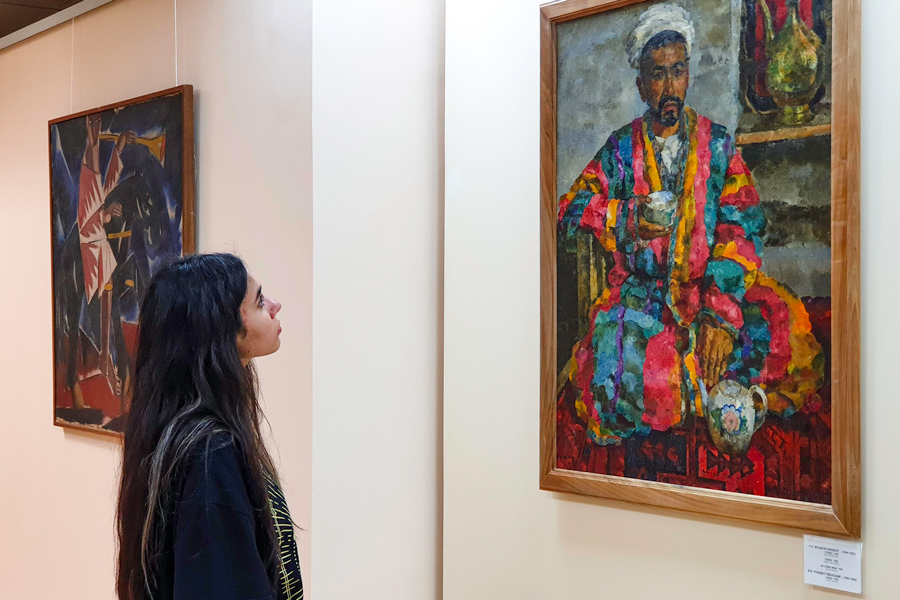
The visual arts of Uzbekistan reflect a rich dialogue between history and innovation. Ancient petroglyphs, medieval miniature painting, and intricate ornamental motifs in ceramics, textiles, and architecture form the foundation of Uzbekistan’s artistic heritage and are a vital expression of the culture of Uzbekistan. The country is also known as the home of a unique museum that preserves works once at risk of disappearing forever. The Savitsky Museum in Nukus, located in the Karakalpakstan desert, holds one of the world’s most remarkable collections of 20th-century Uzbek and Russian avant-garde art, including many pieces that were banned or censored during the Soviet era.
Ancient Art – Petroglyphs
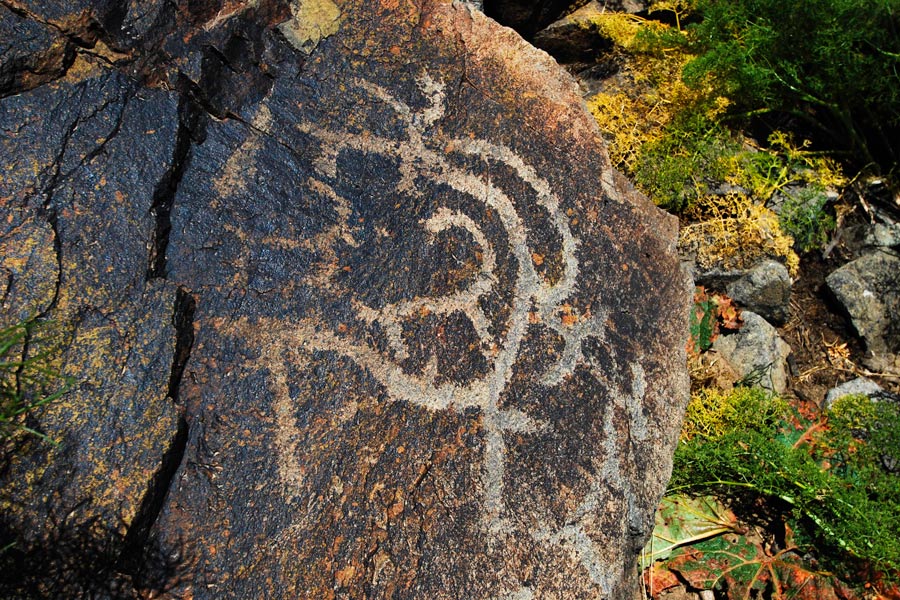
Even tens of thousands of years ago, people found the strength and inspiration to create art despite the daily struggle for survival. Living in caves, they produced rock carvings known as petroglyphs. More than 150 such sites have been preserved across Uzbekistan.
The most famous examples are the Zarautsoy petroglyphs in Surkhandarya, some dating back over 12,000 years, and the Sarmyshsai petroglyphs in Navoi, where about 4,000 rock carvings were created up to 10,000 years ago. Several other remarkable sites can be found near Tashkent, such as Khojikent, Beldersay, and Karakiyasay.
These ancient images reveal how people lived, hunted, performed rituals, and what animals surrounded them. They depict extinct saber-toothed tigers, primitive aurochs, and wild horses.
While most of the figures were carved into stone, some early examples of painting have also survived. One of the most notable is the Zaraut-Kamar Cave near Zarautsoy, which features bull-hunting scenes rendered thousands of years ago using red-brown mineral pigment. These exceptional works are included in UNESCO’s preliminary list of cultural heritage sites.
Ancient Art of Uzbekistan
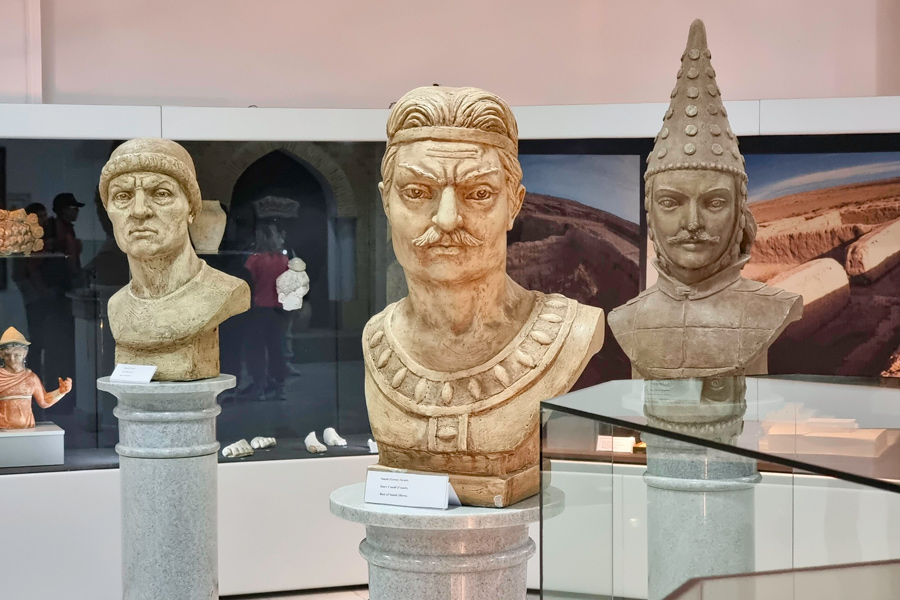
Although ancient art is usually associated with Greece and Rome, the territory of present-day Uzbekistan was also home to developed cities and powerful states in antiquity. The Kushan Empire, for example, was once comparable in scale and significance to the Roman Empire.
The ruins of ancient cities from that period have survived, among them Alexandria Oxiana (Kampyrtepe in Surkhandarya), founded by Alexander the Great in the 4th century BC; Dalverzintepa (Surkhandarya, 1st–4th centuries AD), one of the largest trading centers of the Kushan Empire; and Khalchayan and Fayaz-Tepe (Surkhandarya, 1st–3rd centuries AD). The fortresses of Toprak-Kala and Ayaz-Kala in Karakalpakstan, built more than 2,000 years ago, also date from this era.
These archaeological sites have preserved a remarkable array of artworks. Among the most notable are exquisite items of jewelry – including the renowned 36-kilogram gold treasure of Dalverzintepa – and sculptures such as the Head of the Kushan Prince, created in a synthesis of Buddhist and Hellenistic styles. Fragments of ancient wall paintings have also survived, including frescoes from the Fayaz-Tepe settlement depicting courtiers, the Buddha, and other deities.
Medieval Art
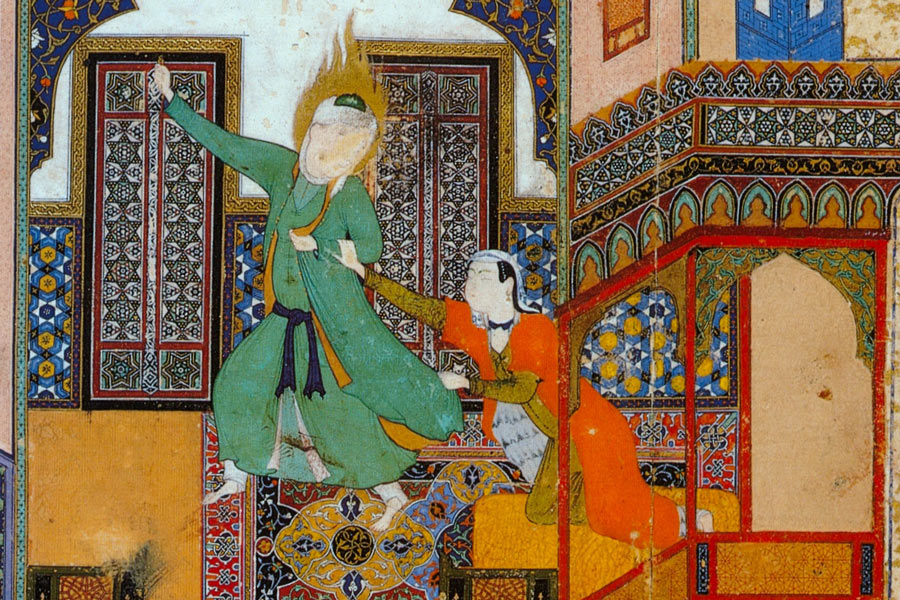
Early medieval art in Uzbekistan is most vividly represented by the frescoes found in the ancient cities of Afrasiab (Samarkand, 7th century) and Varakhsha (near Bukhara, 6th–8th centuries). These vibrant murals depict courtly life, local rulers, and foreign ambassadors. They have been exhibited both in Uzbekistan and internationally, including at the Louvre (Splendeurs des oasis d'Ouzbékistan, 2022–2023) and the British Museum (Silk Roads, 2024–2025).
Following the Arab Caliphate’s conquest of the region in the 8th century, Islamic art began to flourish. As figural representation was prohibited, medieval artistic expression shifted toward intricate ornamentation, calligraphy, and tazhib (gold-leaf illumination) – all of which adorned manuscripts, crafts, and architectural details. These forms remain defining elements of Uzbekistan’s Islamic visual heritage and are now included on UNESCO’s cultural heritage list.
Miniature painting, also recognized by UNESCO, is regarded as a pinnacle of late medieval art in the region. It reached its height during the Timurid era, when the renowned artist Kamoliddin Behzad (1455–1535) created works of exceptional refinement. His paintings, often inspired by literature or historical chronicles, are noted for their sophisticated compositions, expressive faces, richly detailed costumes and interiors, and finely balanced use of color and movement.
Miniatures by Behzad and his followers are now housed in the Behzad State Museum of Miniature Art in Tashkent. Many of his original works are also part of major international collections, including the British Library (London), the Metropolitan Museum (New York), the Russian National Library (St. Petersburg), and the Topkapi Palace (Istanbul).
The miniature tradition was later reinterpreted by the writer and philosopher Ahmad Donish (1827–1897), who illustrated his own manuscripts. His celebrated work Rare Events features miniatures that reflect both Eastern visual traditions and the growing influence of European aesthetics.
This artistic lineage continues in modern Uzbekistan. Among its contemporary practitioners is Anvar Bobobekov, whose solo exhibition in August 2024 showcased 35 original miniatures, highlighting the ongoing vitality of this centuries-old art form.
Art of Uzbekistan in the Late 19th and Early 20th Centuries
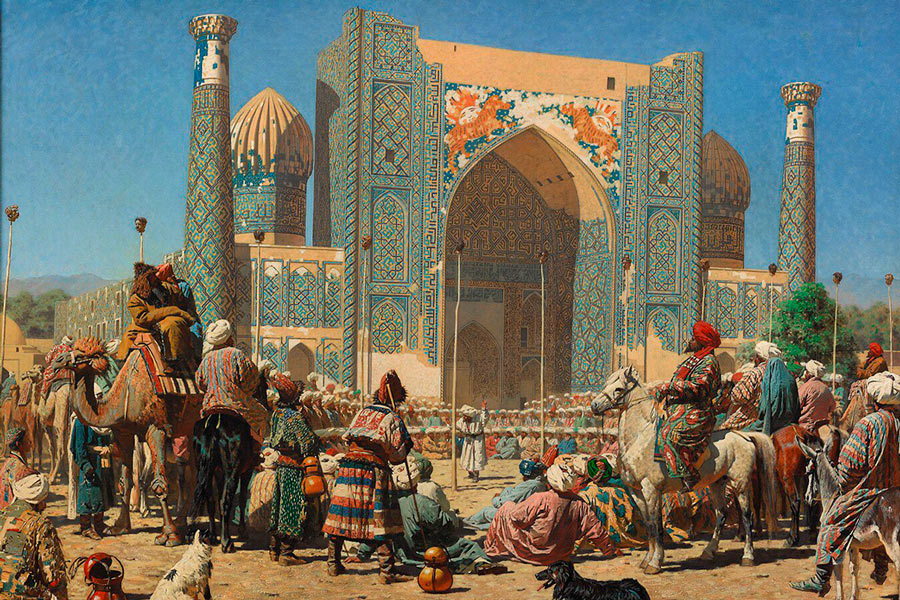
At the end of the 19th century, the territory of modern Uzbekistan was incorporated into the Russian Empire, which led to the introduction of European artistic traditions. These gradually merged with local Eastern aesthetics, forming the distinctive style of 20th-century Uzbek painting.
The foundation for this artistic evolution was laid by Russian painters who arrived in Turkestan at the end of the 19th century, including Richard-Karl Sommer (1866–1939) and Vasily Vereshchagin (1842–1904). Their works vividly captured the atmosphere of historic Uzbek cities, with their majestic architecture, mahallas, mosques, bustling bazaars, and residents in traditional dress.
This is particularly evident in Vereshchagin’s Turkestan Series, which portrays prominent landmarks before restoration, such as the Sherdor Madrasah of the Registan ensemble and the Gur-Emir Mausoleum in Samarkand. These scenes also reflect daily life: Sufi dervishes, musicians with dutars, camels, carved wooden doors, and ornate columns. The series was acquired by Pavel Tretyakov and remains in the collection of the Tretyakov Gallery in Moscow.
In the early 20th century, the vibrant life of Uzbekistan found expression in the paintings of Russian-Soviet artist Pavel Benkov (1879–1949), who arrived in Samarkand in the late 1920s. Already an accomplished artist with experience in Russian institutions and exhibitions in Paris, Benkov created some of his finest works in Uzbekistan, including Old Bukhara, Girl from Khiva, Grape Market, and Bukhara Official. These paintings are notable for their impressionist influence and rich local color.
By the 1920s and 1930s, Uzbekistan had developed its own artistic voice with the emergence of the Central Asian avant-garde – one of the most important movements in 20th-century Uzbek visual art. Key figures include Alexander Volkov (1886–1957), Usto Mumin (Alexander Nikolaev, 1897–1957), Ural Tansykbaev (1904–1974), and Nikolai Karakhan (1900–1970).
Volkov’s work combined elements of modernism, cubism, and Eastern motifs. His best-known painting, Pomegranate Tea House, is admired for its bold color palette and innovative composition. It is now held at the Tretyakov Gallery.
Usto Mumin, a student of Kazimir Malevich, left for Uzbekistan in his youth and adopted a new name and identity. His paintings – The Groom, The Road of Life, and The Story of the Boy with Pomegranate Lips (otherwise known as Pomegranate Zeal) – are imbued with subtlety, spiritual depth, and a refined interpretation of Eastern philosophy.
Ural Tansykbaev, known for his luminous landscapes, earned the nickname “Uzbek Gauguin” for his vivid early works. Notable paintings include Portrait of an Uzbek, Scarlet Autumn, and Evening on the Syr Darya. In 2025, a large-scale retrospective was held at the NBU Gallery to mark the 120th anniversary of his birth. Over 100 works were displayed, with 70 undergoing extensive restoration by French specialists. His life and art are also commemorated at the Ural Tansykbaev Memorial Museum, reopened after major renovations in the same year.
Today, the legacy of Uzbekistan’s early 20th-century avant-garde is carefully preserved and promoted. Major collections are housed at the Savitsky Museum in Nukus, which holds numerous iconic works by avant-garde artists. In 2024, the international exhibition Uzbekistan: Avant-Garde in the Desert was held in Venice and Florence, featuring over 170 works from the Savitsky Museum and the State Museum of Art in Tashkent. Another exhibition, Light Between Worlds (2025), at the New Jerusalem Museum in Russia, explored the shared legacy of the Uzbek and Russian avant-garde of the 1920s and 1930s.
Second Half of the 20th Century
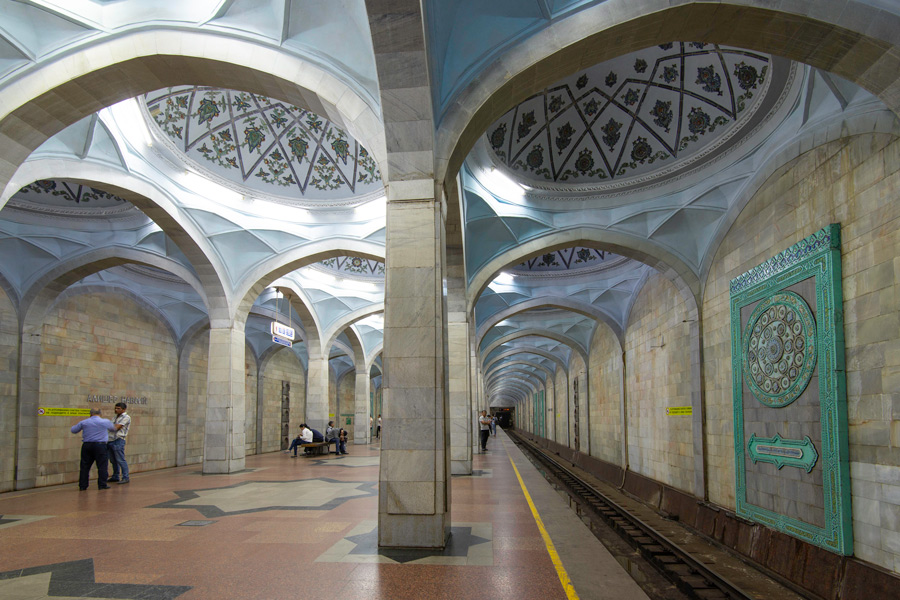
In the second half of the 20th century, realism and psychological depth became central themes in Uzbek painting. These trends are reflected in the works of Rahim Akhmedov (1921–2008), such as Portrait of Karima, Morning, Motherhood, and Sunny Autumn, as well as in Ruza Charyeva’s (1931–2004) paintings Bride, Portrait of an Old Man from Sayrob, and Portrait of a Woman.
A major figure of this period was Chingiz Akhmarov (1912–1995), whose work spans the mid to late 20th century. His paintings explore diverse subjects, with a particular focus on Eastern female beauty, as seen in Woman in Green, Bukhara Dance, and Khorezm Dance. These works reflect the influence of classical Eastern miniatures and are distinguished by the artist’s characteristic use of blue and green tones.
Akhmarov’s connection to literature is most evident in his monumental decorative projects, including the design of the foyer of the Alisher Navoi Opera and Ballet Theatre in Tashkent and his contribution to the celebrated Alisher Navoi station of the Tashkent Metro.
Contemporary Visual Arts in Uzbekistan
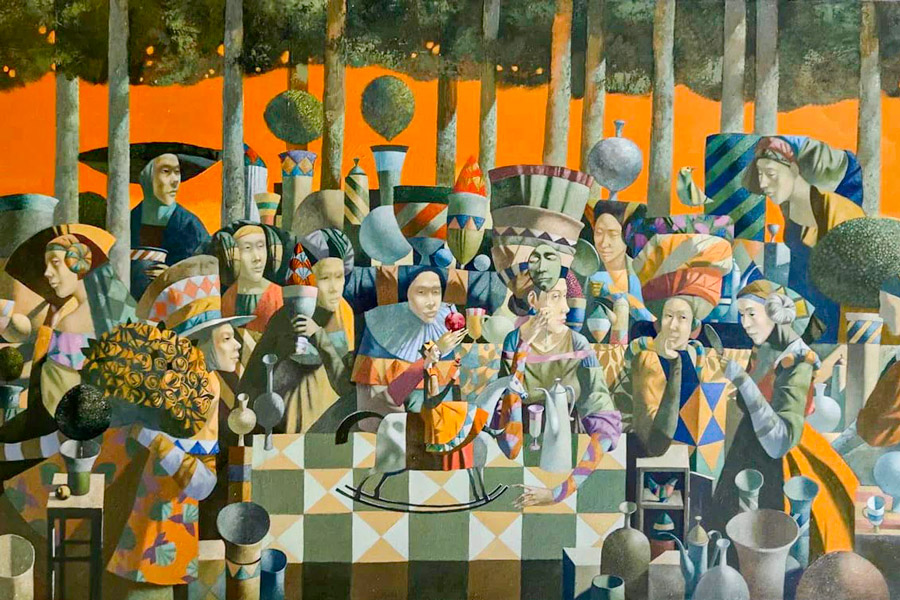
Contemporary Uzbek art blends national traditions with modernist influences from the West. Among the most prominent artists are Lekim Ibragimov (b. 1945), Bahodir Jalal (b. 1948), Alisher Mirzo (b. 1948), Asliddin Isaev (b. 1948), Akmal Nur (b. 1959), Babur Ismailov (b. 1973), and Yura Useinov (b. 1962). Their work builds on the foundations of 20th-century Uzbek painting while embracing bold experimentation and new visual languages.
Much of their art is dedicated to reinterpreting Uzbekistan’s cultural heritage. A classical approach is evident in In the Garden of Ripe Pomegranates and First Love by Akmal Nur, Chairman of the Academy of Arts of Uzbekistan. In addition to his creative work, he plays a key role in arts education and institution-building, having co-founded the Nur Art School and Gallery with artist and art historian Munis Nur.
Metaphorical, historical, and spiritual themes define the work of Asliddin Isaev and Bahodir Jalal. Isaev’s pieces such as Sogdiana, Khazrati Khizr, and Barrier explore national memory and sacred symbolism, while Jalal’s Khiva and the now-lost fresco Birth of Dance express a poetic vision of the region’s past.
Pre-Islamic visual culture has also been a source of inspiration. Ancient murals from Afrasiab and Varakhsha inspired Lekim Ibragimov’s monumental canvas A Thousand Angels and One Painting – a work of vast philosophical depth and unprecedented scale in Uzbek art (66 meters long and 8 meters high).
Many contemporary artists work across both traditional and experimental formats, including video art and installations. Babur Ismailov, for example, describes his style as a “grotesque mixture of cultures”, blending Eastern and Western motifs. This synthesis is reflected in works like Duality, The Story of a Lost Dog, and The Tale of the Prince on a White Horse. In addition to his visual art, Ismailov is the founder of the Artikul32 Gallery, active in curating and organizing art projects. He also contributed to the design of the Eternal City cultural complex in Samarkand, opened in 2022.
The next generation of Uzbek artists continues to expand the field with bold and original approaches. Standout names include Dier Razikov, Serafim Dim, Gayrat Ibragimov, and Timur Rakhmetov, whose works are regularly presented in solo exhibitions. The Regeneration Gallery hosted a striking 2025 exhibition by Serafim Dim titled AJDAHO – Keeper of the Craft, which reinterprets ancient myths and symbols in a highly expressive visual language.
Equally compelling are the works of young artists from Karakalpakstan – Temur Shardemetov, Salamat Babajanov, Bakhtiyar Serekeev, and Nauryz Aitmuratov – who bring regional perspectives to the national art scene. Many of their paintings were created following a 2025 study trip to Italy and France, organized by the Regeneration Gallery. More than 100 of these works formed the core of a major exhibition that same year at the Central Exhibition Hall in Tashkent.
Top Art Museums and Galleries in Uzbekistan
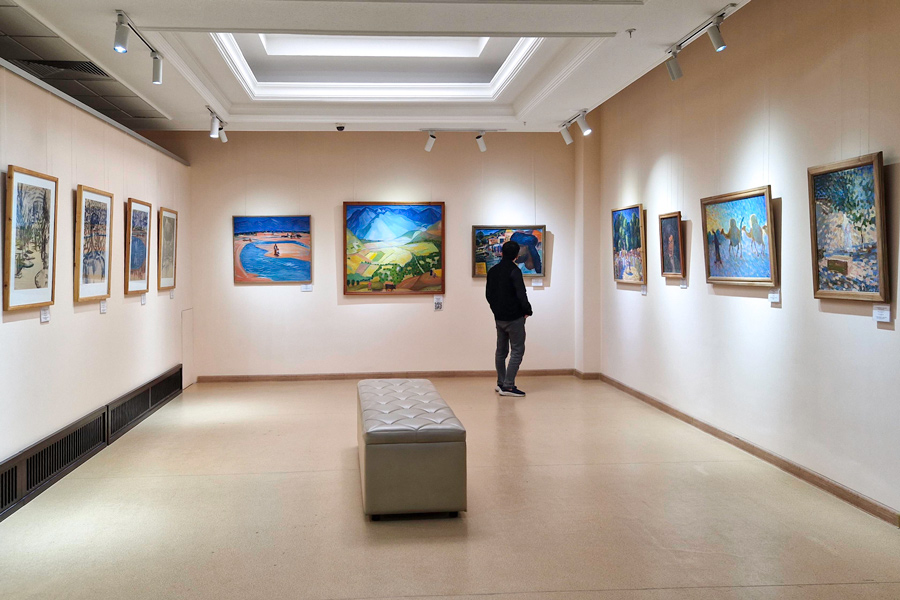
The most comprehensive collections of paintings by Uzbek artists are housed in the country’s leading museums and galleries. Chief among them are the State Museum of Art of Uzbekistan in Tashkent and the I.V. Savitsky Museum in Nukus, often referred to as the “Louvre in the Desert”.
These institutions also feature rare works by international artists. The Savitsky Museum is renowned for its collection of Moscow avant-garde art, while the State Museum of Art holds three Compositions by Wassily Kandinsky, alongside other important modernist works.
Major cities across Uzbekistan regularly host exhibitions and art festivals. Among the most prominent are the Regeneration Art Fest (2024), dedicated to emerging artists, and the Bukhara Biennal (September–November 2025), which has been praised by international publications such as the Financial Times and Frieze.
Many contemporary initiatives are supported by the Uzbekistan Culture and Arts Development Foundation. One of its key projects is the Center for Contemporary Art in Tashkent, opened in 2020 and directed by guest curator Dr. Sara Raza, originally from London. Located in a restored 1912 building, the center serves as a vibrant hub for international exhibitions, research, and creative dialogue.
Uzbekistan is a country deeply infused with art. And to experience it, you don’t always need to visit a museum. In Tashkent and beyond, visitors can admire intricate ornamental details on centuries-old Islamic architecture, or encounter vibrant Soviet-era mosaic panels on residential buildings – of which Tashkent has more than any other city in the world.
Modern Fine Art of Uzbekistan:
Museums and galleries of Uzbekistan
Interview with one of the most famous artists of Uzbekistan - Akmal Nur. October, 2012

